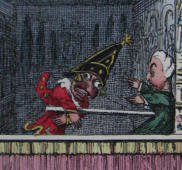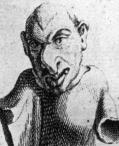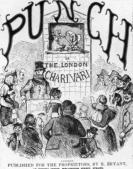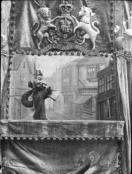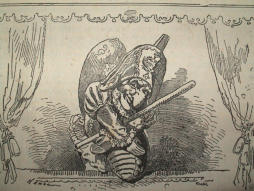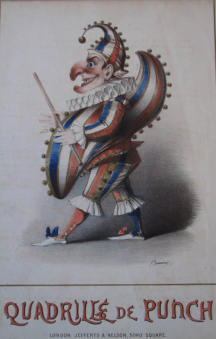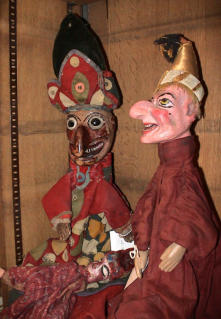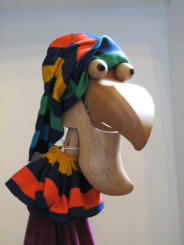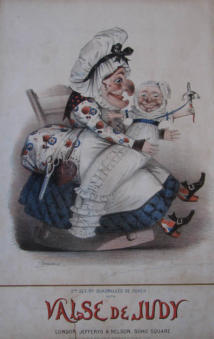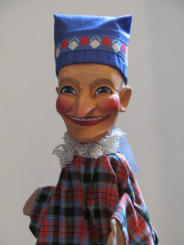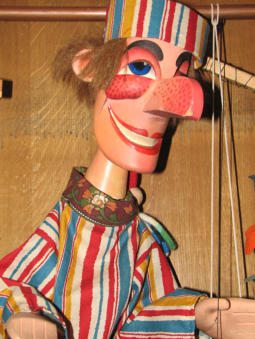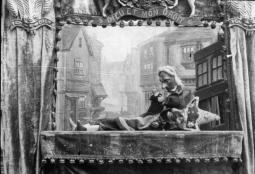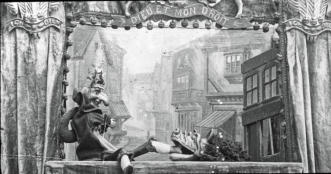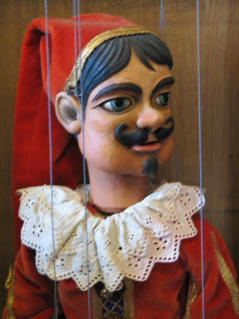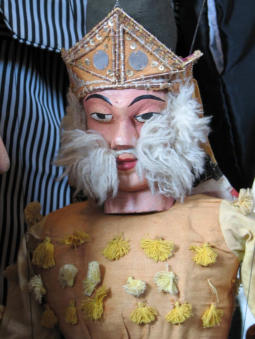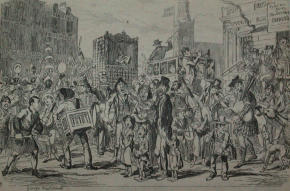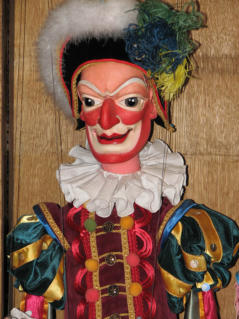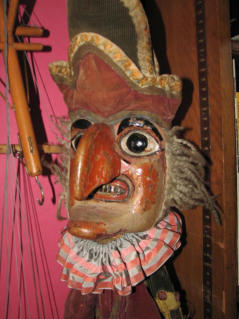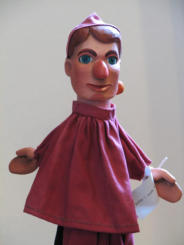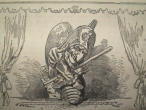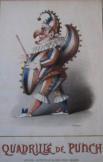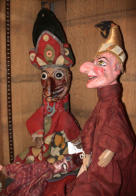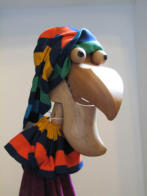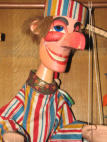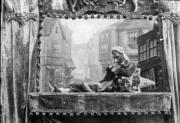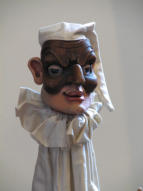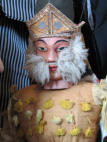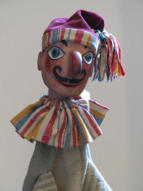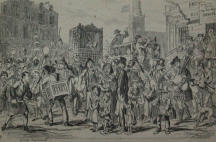NAVIGATION
SOCIAL
CONTACT
e-mail: info@theworldthroughwoodeneyes.co.uk


Punch
THE IMMORTAL VILLAIN - MISTER PUNCH
In
1662
Samuel
Pepys,
the
diarist,
noted
that
during
his
stroll
in
Covent
Garden
he
saw
a
hooked-nose,
red-faced
personage
with
a
high
pitched
squeaky
voice
-
his
name
Punchinello.
This
was
the
first
time
that
he
appeared
in
Great
Britain
and
at
that
time
was
a
marionette,
or
string
puppet,
without the now familiar cast of characters we are used to seeing with him.
Mister
Punch
is,
by
origin,
an
ancient
character.
In
the
Greek
and
Roman
theatre
we
find
grotesque
characters,
particularly
Maccus and Buccus, generally thought to be the forerunners of our popular comic folk hero.
In
the
14th
century
illustrated
manuscript
'The
Romance
of
Alexander',
of
Flemish
origin,
two
illustrations
show
puppet
performances
in
a
booth
called
a
castelet.
The
performance
is
that
of
jousting
puppets
and
is
the
first
printed
image
of
a
form
puppet stage similar to the well known Punch and Judy booth.
In
1625
the
painter
and
engraver
Jacques
Callot
produced
a
series
of
works
with
the
title
'The
Balli
de
Sfessania'
showing
the
early
characters
of
the
Commedia
del'Arte.
One
of
the
characters
is
Pulcinella.
With
the
rising
popularity
of
this
character,
an
enterprising
puppeteer
near
Naples
created
a
glove
or
hand
puppet
with
the
familiar
white
costume
and
black
half-
mask.
Slowly,
with
the
popularity
of
Pulcinella
and
his
travels
beyond
Italy,
changes
to
his
costume
and
facial
features
resulted
in
a
character
in
France
by
the
name
of
Polichinelle.
In
other
parts
of
Central
and
Eastern
Europe
other
comic
folk
heroes
emerged
-
Kasper,
Kasperl,
Kasparek,
Vasliache,
Petrushka
etc,
all
hand puppets except the Czech Kasparek who was a marionette like Polichinelle.
Punchinello,
later
known
as
Punch
-
said
to
be
the
result
of
the
English
laziness
or
the
inability
to
accurately
pronounce
the
foreign
sounding
name
-
performed
as
an
independent
character
in
other
dramas
as
a
puppet
or
human
actor.
These
performances
were
in
fit-up
theatres
in
Fair's
such
as
those
of
Bartholomew
and
Southwark.
A
detail
in
William
Hogarth's
magnificent
engraving
of
1773
shows
'Punch's
Opera'
and
'Adam
and
Eve',
and
close-by,
a small booth with jousting puppets.
William
Hogarth's
engraving
is
full
of
detail,
recreating
the
unique
character
of
these
Fairs
that
were
ultimately
closed
down
due
to
the
many
improper
practises
there.
With
their
closure,
Mister
Punch
was
forced
into
finding
other
ways
of
developing
his
character
and
popularity
with
a
smaller
and
more
portable
stage.
At
this
point
he
became
a
hand
puppet
and
slowly
the
now
familiar
striped
chimney-stack
booth
emerged
and
a
whole
new
cast
of
characters
with
it
-
most
of
them
based
on
the
many
characters
to
be
found
in
everyday
domestic
life
plus
the
Devil,
a
crocodile
and
also
a
dolphin!
One
of
the
most
popular
Punch
and
Judy
men,
Piccini
-
of
Italian
origin
-
was
celebrated
by
the
journalist
John
Payne
Collier
(1789-1883)
who
wrote
down
the
text
of
the
play
whilst
the
artist
George
Cruikshank
(1792-1878)
sketched
the
numerous
scenes.
This
was
ultimately
published
in
1828
followed
by
many
editions
of
the
work
to the present day.
Vast
numbers
of
Punch
and
Judy
publications
were
produced
during
the
19th
century,
particularly
the
highly
coloured
(frequently
hand-coloured)
books
for
children
which
include
valuable
moveable
and
profiled
books.
Then
came
the
popular
Punch
satirical
magazine
that
was
published
until
the
end
of
the
20th
century.
The
vast
quantities
of
toys,
ceramics,
objects
of
gold
and
silver
and
other
metals
and
materials
bears
out
the
continuing popularity of Mr Punch to people of all ages and all walks of life.
Since
the
earliest
appearance
of
Mr
Punch
there
have
been
continuous
rumours
that
he was on the way out but he never disappears.
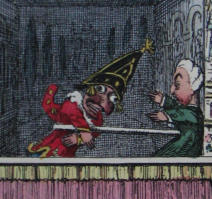
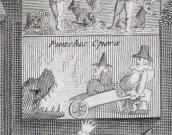


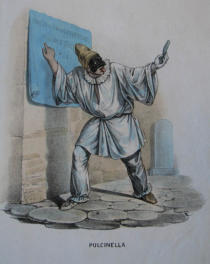
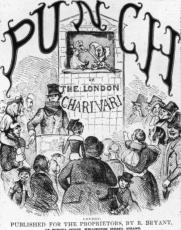
CONTACT
e-mail: info@theworldthroughwoodeneyes.co.uk
SOCIAL


Punch
THE
IMMORTAL
VILLAIN
-
MISTER
PUNCH
In
1662
Samuel
Pepys,
the
diarist,
noted
that
during
his
stroll
in
Covent
Garden
he
saw
a
hooked-nose,
red-faced
personage
with
a
high
pitched
squeaky
voice
-
his
name
Punchinello.
This
was
the
first
time
that
he
appeared
in
Great
Britain
and
at
that
time
was
a
marionette,
or
string
puppet,
without
the
now
familiar
cast
of
characters we are used to seeing with him.
Mister
Punch
is,
by
origin,
an
ancient
character.
In
the
Greek
and
Roman
theatre
we
find
grotesque
characters,
particularly
Maccus
and
Buccus,
generally
thought
to
be
the
forerunners of our popular comic folk hero.
In
the
14th
century
illustrated
manuscript
'The
Romance
of
Alexander',
of
Flemish
origin,
two
illustrations
show
puppet
performances
in
a
booth
called
a
castelet.
The
performance
is
that
of
jousting
puppets
and
is
the
first
printed
image
of
a
form
puppet
stage
similar
to
the
well
known
Punch
and Judy booth.
In
1625
the
painter
and
engraver
Jacques
Callot
produced
a
series
of
works
with
the
title
'The
Balli
de
Sfessania'
showing
the
early
characters
of
the
Commedia
del'Arte.
One
of
the
characters
is
Pulcinella.
With
the
rising
popularity
of
this
character,
an
enterprising
puppeteer
near
Naples
created
a
glove
or
hand
puppet
with
the
familiar
white
costume
and
black
half-mask.
Slowly,
with
the
popularity
of
Pulcinella
and
his
travels
beyond
Italy,
changes
to
his
costume
and
facial
features
resulted
in
a
character
in
France
by
the
name
of
Polichinelle.
In
other
parts
of
Central
and
Eastern
Europe
other
comic
folk
heroes
emerged
-
Kasper,
Kasperl,
Kasparek,
Vasliache,
Petrushka
etc,
all
hand
puppets
except the Czech Kasparek who was a marionette like Polichinelle.
Punchinello,
later
known
as
Punch
-
said
to
be
the
result
of
the
English
laziness
or
the
inability
to
accurately
pronounce
the
foreign
sounding
name
-
performed
as
an
independent
character
in
other
dramas
as
a
puppet
or
human
actor.
These
performances
were
in
fit-up
theatres
in
Fair's
such
as
those
of
Bartholomew
and
Southwark.
A
detail
in
William
Hogarth's
magnificent
engraving
of
1773
shows
'Punch's
Opera'
and
'Adam
and
Eve',
and
close-by,
a
small booth with jousting puppets.
William
Hogarth's
engraving
is
full
of
detail,
recreating
the
unique
character
of
these
Fairs
that
were
ultimately
closed
down
due
to
the
many
improper
practises
there.
With
their
closure,
Mister
Punch
was
forced
into
finding
other
ways
of
developing
his
character
and
popularity
with
a
smaller
and
more
p
o
r
t
a
b
l
e
s
t
a
g
e
.
At
this
point
he
became
a
hand
puppet
and
slowly
the
now
familiar
striped
chimney-stack
booth
emerged
and
a
whole
new
cast
of
characters
with
it
-
most
of
them
based
on
the
many
characters
to
be
found
in
everyday
domestic
life
plus
the
Devil,
a
crocodile
and also a dolphin!
One
of
the
most
popular
Punch
and
Judy
men,
Piccini
-
of
Italian
origin
-
was
celebrated
by
the
journalist
John
Payne
Collier
(1789-1883)
who
wrote
down
the
text
of
the
play
whilst
the
artist
George
Cruikshank
(1792-
1878)
sketched
the
numerous
scenes.
This
was
ultimately
published
in
1828
followed
by
many
editions
of
the work to the present day.
Vast
numbers
of
Punch
and
Judy
publications
were
produced
during
the
19th
century,
particularly
the
highly
coloured
(frequently
hand-coloured)
books
for
children
which
include
valuable
moveable
and
profiled
books.
Then
came
the
popular
Punch
satirical
magazine
that
was
published
until
the
end
of
the
20th
century.
The
vast
quantities
of
toys,
ceramics,
objects
of
gold
and
silver
and
other
metals
and
materials
bears
out
the
continuing
popularity
of
Mr
Punch
to
people
of
all
ages
and
all
walks
of
life.
Since
the
earliest
appearance
of
Mr
Punch
there
have
been
continuous
rumours
that
he
was
on
the
way
out
but
he
never
disappears.
